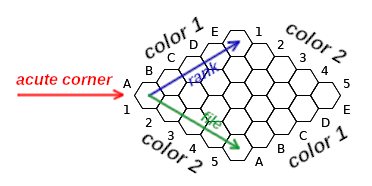Difference between revisions of "Conventions"
(A very first draft of a page listing various conventions that people use. Todo: complete the information. Also, rewrite in a more neutral way, i.e., without preferring any convention (except maybe in a separate "recommendation" section)) |
(Updated introductory paragraph, to indicate that the conventions are now more stable than when the article was first written) |
||
| (29 intermediate revisions by 3 users not shown) | |||
| Line 1: | Line 1: | ||
| − | This page lists | + | This page lists possible conventions for Hex games. These conventions concern the color of the players, who goes first, the orientation of the board, and the numbering of the cells on the board. Unlike much older games such as Chess and Go, Hex has no governing body that could set standardized rules, and for most of its history, different people, game sites, books, and computer programs sometimes use different conventions. However, in the last few years, most sites have converged on a compatible set of conventions, making game records more easily interchangeable. |
| − | We distinguish | + | We distinguish ''logical'' from ''physical'' conventions. Logical conventions are concerned with the abstract rules of Hex, irrespectively of how the players visualize the game. Physical conventions relate to the specific appearance of the game board. When the game is played remotely, for example on an internet game server or over email, it is in principle possible for the two players to follow different physical conventions; for example, each player may choose their own preferred orientation of the board, or their own preferred colors for the pieces. However, both players should follow the same logical conventions. |
| − | == | + | == Universal vs. local conventions == |
| − | There are several aspects of a game of Hex that are | + | There are several aspects of a game of Hex that are arbitrary and do not affect game play in an essential way. This includes the orientation (rotation and reflection) of the board, the colors of the players, who goes first, which edge belongs to which player, and whether and how the cells on the board are numbered. |
| + | |||
| + | The same also applies to other games; for example, the game of Chess would not change in an essential way if the white square were in the bottom left corner instead of the bottom right one, if black went first instead of white, if the white queen started on a black square instead of a white one, if the ranks were lettered and the files numbered instead of the other way around, and so on. | ||
| + | |||
| + | In the case of established games such as Chess and Go, there are universal conventions that all players have agreed on. This has certain advantages. For example, every chess player understands what it means to move a white pawn from d2 to d4, without requiring further explanation. | ||
| + | |||
| + | In Hex, there were no universal conventions prior to ca. 2020, and different players, books, game sites, tournaments, or Hex programs often used different conventions. Fortunately, some universal conventions seem to have crystallized in recent years, especially for the logical aspects of the game (such as the coordinate system and who goes first). Some physical conventions also seem to have become standard; for example, the colors are now almost universally black/white or red/blue, with black or red going first. Some conventions are unsettled; for example, both swap methods (swap-pieces and swap-sides) seem to be in common use. This is not a problem as long as game records specify which method is used. Other conventions, such as the board orientation, seem to depend on user preference and probably don't need to be standardized, although there is a strong preference for positive orientations. | ||
== Logical conventions == | == Logical conventions == | ||
| − | + | === Cell naming === | |
| − | + | Cells are arranged in a grid, with each cell named by a letter and a number. Letters can be uppercase or lowercase. The following convention seems to be nearly universally used: | |
| − | + | [[Image:Logical-Board.png|right|]] | |
| − | + | '''Convention: coordinate origin''' | |
| − | + | Possible values: | |
| − | * | + | * '''Acute:''' The cell A1 is an an acute corner of the board. |
| − | + | In particular, this means that the three cells A1, B1, and A2 are all adjacent to each other. | |
| − | Note that the logical conventions are purely symbolic. They do not depend on any particular board layout. | + | For the purpose of the following exposition, it is useful to refer to the cells that share a common number as a "rank", and to the cells that share a common letter as a "file", as in Chess. For example, the 1-rank consists of the cells A1, B1, C1, etc., and the A-file consists of the cells A1, A2, A3, etc. |
| + | |||
| + | Note that in some games, such as Go, it is customary to omit certain letters from the alphabet, especially the letter I. This is done "to avoid confusion between I and J", and presumably dates from a time when typesetting was uncommon and people had terrible handwriting. However, in Hex, the standard 26-letter alphabet is used. If more than 26 letters are needed, alphabet numbers can be used: the next file after Z is AA, then AB, and so on. | ||
| + | |||
| + | === Edge coloring === | ||
| + | |||
| + | To avoid referencing specific physical attributes of the game, we will refer to the color of the first piece played in the game as "color 1", and to the other color as "color 2". One pair of opposite edges "belongs to" color 1; these are the edges that the player who is playing color 1 is trying to connect. The other pair of opposite edges belongs to color 2. | ||
| + | |||
| + | '''Convention: edge coloring''' | ||
| + | |||
| + | Possible values: | ||
| + | |||
| + | * '''Normal:''' The edge that is adjacent to the 1-rank belongs to color 1, and the edge that is adjacent to the A-file belongs to color 2. | ||
| + | |||
| + | In other words, the normal edge coloring convention states that the color 1 edges are parallel to ranks, and the color 2 edges are parallel to files. In a typical rendering of the board, the letters (naming files) are written along the color 1 edge and the numbers (naming ranks) are written along the color 2 edge. | ||
| + | |||
| + | I am not aware of anybody who has used the opposite convention. However, there are some authors who use no edge coloring convention at all. | ||
| + | |||
| + | === Swapping === | ||
| + | |||
| + | There are two different ways of implementing the [[swap rule]]. Which convention is chosen will affect the notation for games. It is also possible to permit both methods of swapping; then it is up to the player to decide which method to use. | ||
| + | |||
| + | '''Convention: swap method''' | ||
| + | |||
| + | Possible values: | ||
| + | |||
| + | * '''Swap sides:''' Upon playing a swap move, the board position stays the same and the players change colors. | ||
| + | |||
| + | * '''Swap pieces:''' Upon playing a swap move, the players keep their colors and the board position is mirrored (ranks and files interchanged) and the color of the pieces is inverted. For example, a black piece at A2 would be replaced by a white piece at B1. | ||
| + | |||
| + | Here is an example using the swap sides convention: Player 1 plays a black piece at g4. Player 2 swaps sides. The board state remains unchanged, and immediately after the swap, it is player 1's turn to play a white piece. | ||
| + | |||
| + | Here is an example using the swap pieces convention: Player 1 plays a black piece at g4. Player 2 swaps pieces, and replaces the black piece at g4 with a white piece at d7. Immediately after the swap, it is player 1's turn to play a black piece. | ||
| + | |||
| + | When using algebraic notation for a sequence of moves, it is important to know which swap method was used. The swap method should either be defined for the context in which it is used, or else the notation should state explicitly which method was used. For example, with the swap sides convention, the notation "g4 swap f7 e7" means player 1 plays color 1 at g4, player 2 swaps, player 1 plays color 2 at f7, and player 2 plays color 1 at e7. With the swap pieces convention, the same game would be described as "g4 swap g6 g5". Here, player 1 plays color 1 at g4, player 2 replaces this by a piece by color 2 at d7, then player 1 plays color 1 at g6 and player 2 plays color 2 at g5. It is best not to use ambiguous notation at all; the two games can then be denoted "g4 swap-sides f7 e7" and "g4 swap-pieces g6 g5". | ||
| + | |||
| + | Note that the above logical conventions are purely symbolic. They do not depend on any particular board layout. | ||
| + | |||
| + | === Passing === | ||
| + | |||
| + | Although passing (skipping a move) is not always considered part of the classic Hex rules, allowing it does not change the nature of the game and has certain advantages. See the page on [[passing]] for more details. | ||
| + | |||
| + | '''Convention: passing''' | ||
| + | |||
| + | Possible values: | ||
| + | |||
| + | * '''Explicit''': Players can pass and there is an explicit passing move in the game record, e.g.: "Black passed". | ||
| + | |||
| + | * '''Implicit''': There is no explicit passing move, but a player can move twice in a row (presumably when the other player allows it). | ||
| + | |||
| + | * '''None''': Moves must be strictly alternating and passing is not allowed. | ||
== Physical conventions == | == Physical conventions == | ||
| − | + | === Colors === | |
| − | + | The most common color schemes are: | |
| − | * | + | * Black and white. |
| + | * Red and blue. | ||
| + | * V and H. | ||
| − | + | With each color scheme, there are two possible conventions to which color is color 1. The more common conventions seem to be "black goes first", "red goes first", and "V goes first", but the opposite conventions also exist. | |
| − | + | === Board orientation === | |
| − | + | ||
| − | * | + | The board can be oriented in a number of different ways. It can be oriented in the ''positive'' or ''negative'' senses, and rotated to various angles. |
| + | |||
| + | '''Convention: board sense''' | ||
| + | |||
| + | Possible values: | ||
| + | |||
| + | * '''Positive:''' The cells A1, B1, A2 form a clockwise triangle in that order. | ||
| + | |||
| + | * '''Negative:''' The cells A1, B1, A2 form a counterclockwise triangle in that order. | ||
| + | |||
| + | The positive sense can also be described by saying that if the board is rotated so that A1 points west, then the ranks run from southwest to northeast, and the files run from northwest to southeast. This convention can also be described as "letters above numbers", because if A1 points left, the letters A,B,C marking the files appear above the numbers 1,2,3 marking the ranks. | ||
| + | |||
| + | '''Convention: board rotation''' | ||
| + | |||
| + | There is probably no need for a preferred board rotation; indeed, players using a physical game board may freely move around the board and look at it from any angle they want. | ||
| + | |||
| + | In computer hex, the most common board rotations are: | ||
| + | |||
| + | * '''Diamond:''' the A1 corner points west, i.e., in the direction of 9 o'clock on an analog clock. | ||
| + | |||
| + | * '''Flat:''' the A1 corner points northwest, i.e., in the direction of 10 o'clock. | ||
| + | |||
| + | * '''Flat II:''' the A1 corner points southwest, i.e., in the direction of 8 o'clock. | ||
| + | |||
| + | The following table illustrates some common board layouts. Here, color 1 is shown as black and color 2 is shown as white. | ||
| + | |||
| + | {| class="wikitable" style="text-align: center" | ||
| + | |- | ||
| + | | [[Image:Positive-Diamond.png|250px]] | ||
| + | |||
| + | Positive diamond | ||
| + | | [[Image:Positive-Flat.png|250px]] | ||
| + | |||
| + | Positive flat | ||
| + | | [[Image:Positive-Flat2.png|250px]] | ||
| + | |||
| + | Positive flat II | ||
| + | |- | ||
| + | | [[Image:Negative-Diamond.png|250px]] | ||
| + | |||
| + | Negative diamond | ||
| + | | [[Image:Negative-Flat.png|250px]] | ||
| + | |||
| + | Negative flat | ||
| + | | [[Image:Negative-Flat2.png|250px]] | ||
| + | |||
| + | Negative flat II | ||
| + | |} | ||
== List of conventions used == | == List of conventions used == | ||
| Line 44: | Line 149: | ||
|- | |- | ||
! | ! | ||
| − | ! | + | ! Origin |
| − | ! Edge | + | ! Edge coloring |
! Swap | ! Swap | ||
| − | ! | + | ! Passing |
| − | ! | + | ! Colors |
| − | ! | + | ! First player |
| + | ! Orientation | ||
|- | |- | ||
| Browne | | Browne | ||
| − | | | + | | acute |
| − | | | + | | normal |
| − | | | + | | sides |
| − | | | + | | N/A |
| − | | | + | | black/white |
| − | | | + | | black |
| + | | positive diamond | ||
|- | |- | ||
| Seymour | | Seymour | ||
| − | | | + | | acute |
| − | | | + | | normal |
| − | | | + | | pieces |
| − | | | + | | explicit in puzzles, none in book |
| − | | | + | | black/white |
| − | | | + | | black |
| + | | positive diamond | ||
|- | |- | ||
| Berge | | Berge | ||
| − | | | + | | acute |
| + | | normal | ||
| ? | | ? | ||
| + | | N/A | ||
| + | | black/white | ||
| + | | white | ||
| + | | negative flat II | ||
| + | |- | ||
| + | | Hayward and Toft | ||
| + | | acute | ||
| ? | | ? | ||
| − | | | + | | sides |
| − | | | + | | N/A |
| − | | | + | | black/white |
| + | | any | ||
| + | | diamond | ||
|- | |- | ||
| Hexy | | Hexy | ||
| − | | | + | | acute |
| − | | | + | | normal |
| − | | | + | | pieces |
| − | | | + | | none |
| − | | | + | | red/blue |
| − | | | + | | red |
| + | | positive diamond / positive flat / negative flat II | ||
|- | |- | ||
| Mohex | | Mohex | ||
| − | | | + | | acute |
| − | | | + | | normal |
| − | | | + | | N/A |
| − | | | + | | implicit |
| − | | | + | | black/white |
| − | | | + | | black |
| − | |- | + | | positive flat |
| − | | | + | |- |
| − | | | + | | HexGui |
| − | | | + | | acute |
| − | | | + | | normal |
| − | | | + | | both |
| − | | | + | | implicit |
| − | | | + | | black/white |
| + | | black | ||
| + | | any | ||
|- | |- | ||
| Board Game Arena | | Board Game Arena | ||
| − | | | + | | acute |
| − | | | + | | normal |
| − | | | + | | pieces |
| − | | | + | | explicit |
| − | | | + | | red/blue |
| − | | | + | | red |
| + | | positive flat | ||
|- | |- | ||
| Little Golem | | Little Golem | ||
| − | | | + | | acute |
| − | | | + | | normal |
| − | | | + | | pieces |
| − | | | + | | none |
| − | | | + | | black/white |
| − | | | + | | black |
| + | | positive flat | ||
|- | |- | ||
| igGameCenter | | igGameCenter | ||
| − | | | + | | acute |
| − | | | + | | normal |
| − | | | + | | sides |
| − | | | + | | none |
| − | | | + | | red/blue or black/white |
| − | | | + | | red or black |
| + | | positive flat | ||
| + | |- | ||
| + | | PlayOK | ||
| + | | acute | ||
| + | | normal | ||
| + | | pieces | ||
| + | | none | ||
| + | | black/white | ||
| + | | black | ||
| + | | positive flat | ||
| + | |- | ||
| + | | PlayHex | ||
| + | | acute | ||
| + | | normal | ||
| + | | pieces | ||
| + | | explicit | ||
| + | | red/blue | ||
| + | | red | ||
| + | | any positive | ||
| + | |- | ||
| + | | AbstractPlay | ||
| + | | acute | ||
| + | | normal | ||
| + | | pieces | ||
| + | | none | ||
| + | | red/blue | ||
| + | | red | ||
| + | | positive flat | ||
| + | |- | ||
| + | | HexWorld | ||
| + | | acute | ||
| + | | normal | ||
| + | | both | ||
| + | | explicit | ||
| + | | black/white or red/blue | ||
| + | | black or red | ||
| + | | any positive | ||
| + | |- | ||
| + | | TRMPH | ||
| + | | acute | ||
| + | | normal | ||
| + | | N/A | ||
| + | | none | ||
| + | | black/white | ||
| + | | black | ||
| + | | positive flat | ||
| + | |-j | ||
| + | | HexWiki | ||
| + | | acute | ||
| + | | normal | ||
| + | | both | ||
| + | | N/A | ||
| + | | red/blue | ||
| + | | red | ||
| + | | positive flat | ||
|} | |} | ||
| − | Notes: Browne states that there is no universal convention for which color goes first, but | + | Notes: |
| + | |||
| + | * Browne states that there is no universal convention for which color goes first, but black goes first in all examples in the book. | ||
| + | |||
| + | * Berge states that any player can go first, but white goes first in his example games. | ||
| + | |||
| + | * TRMPH implements swapping incorrectly. It changes the color of the piece, but not its location. | ||
| + | |||
| + | * MoHex does not implement a swap-pieces move. It implements swap-sides, which it incorrectly (and confusingly) calls swap-pieces. | ||
| + | |||
| + | * BoardGameArena has an explicit passing move, but three consecutive passes are not allowed. Therefore, if a player passes, the opponent can effectively reject the pass by passing too. | ||
| + | |||
| + | * AbstractPlay uses red and blue as the default colors, but users can set custom colors for themselves (these are not seen by the opponent). It uses the positive flat orientation and the board can be rotated in increments of 90 degrees. | ||
| + | |||
| + | [[category: Rules and Conventions]] | ||
Latest revision as of 17:38, 6 June 2025
This page lists possible conventions for Hex games. These conventions concern the color of the players, who goes first, the orientation of the board, and the numbering of the cells on the board. Unlike much older games such as Chess and Go, Hex has no governing body that could set standardized rules, and for most of its history, different people, game sites, books, and computer programs sometimes use different conventions. However, in the last few years, most sites have converged on a compatible set of conventions, making game records more easily interchangeable.
We distinguish logical from physical conventions. Logical conventions are concerned with the abstract rules of Hex, irrespectively of how the players visualize the game. Physical conventions relate to the specific appearance of the game board. When the game is played remotely, for example on an internet game server or over email, it is in principle possible for the two players to follow different physical conventions; for example, each player may choose their own preferred orientation of the board, or their own preferred colors for the pieces. However, both players should follow the same logical conventions.
Contents
[hide]Universal vs. local conventions
There are several aspects of a game of Hex that are arbitrary and do not affect game play in an essential way. This includes the orientation (rotation and reflection) of the board, the colors of the players, who goes first, which edge belongs to which player, and whether and how the cells on the board are numbered.
The same also applies to other games; for example, the game of Chess would not change in an essential way if the white square were in the bottom left corner instead of the bottom right one, if black went first instead of white, if the white queen started on a black square instead of a white one, if the ranks were lettered and the files numbered instead of the other way around, and so on.
In the case of established games such as Chess and Go, there are universal conventions that all players have agreed on. This has certain advantages. For example, every chess player understands what it means to move a white pawn from d2 to d4, without requiring further explanation.
In Hex, there were no universal conventions prior to ca. 2020, and different players, books, game sites, tournaments, or Hex programs often used different conventions. Fortunately, some universal conventions seem to have crystallized in recent years, especially for the logical aspects of the game (such as the coordinate system and who goes first). Some physical conventions also seem to have become standard; for example, the colors are now almost universally black/white or red/blue, with black or red going first. Some conventions are unsettled; for example, both swap methods (swap-pieces and swap-sides) seem to be in common use. This is not a problem as long as game records specify which method is used. Other conventions, such as the board orientation, seem to depend on user preference and probably don't need to be standardized, although there is a strong preference for positive orientations.
Logical conventions
Cell naming
Cells are arranged in a grid, with each cell named by a letter and a number. Letters can be uppercase or lowercase. The following convention seems to be nearly universally used:
Convention: coordinate origin
Possible values:
- Acute: The cell A1 is an an acute corner of the board.
In particular, this means that the three cells A1, B1, and A2 are all adjacent to each other.
For the purpose of the following exposition, it is useful to refer to the cells that share a common number as a "rank", and to the cells that share a common letter as a "file", as in Chess. For example, the 1-rank consists of the cells A1, B1, C1, etc., and the A-file consists of the cells A1, A2, A3, etc.
Note that in some games, such as Go, it is customary to omit certain letters from the alphabet, especially the letter I. This is done "to avoid confusion between I and J", and presumably dates from a time when typesetting was uncommon and people had terrible handwriting. However, in Hex, the standard 26-letter alphabet is used. If more than 26 letters are needed, alphabet numbers can be used: the next file after Z is AA, then AB, and so on.
Edge coloring
To avoid referencing specific physical attributes of the game, we will refer to the color of the first piece played in the game as "color 1", and to the other color as "color 2". One pair of opposite edges "belongs to" color 1; these are the edges that the player who is playing color 1 is trying to connect. The other pair of opposite edges belongs to color 2.
Convention: edge coloring
Possible values:
- Normal: The edge that is adjacent to the 1-rank belongs to color 1, and the edge that is adjacent to the A-file belongs to color 2.
In other words, the normal edge coloring convention states that the color 1 edges are parallel to ranks, and the color 2 edges are parallel to files. In a typical rendering of the board, the letters (naming files) are written along the color 1 edge and the numbers (naming ranks) are written along the color 2 edge.
I am not aware of anybody who has used the opposite convention. However, there are some authors who use no edge coloring convention at all.
Swapping
There are two different ways of implementing the swap rule. Which convention is chosen will affect the notation for games. It is also possible to permit both methods of swapping; then it is up to the player to decide which method to use.
Convention: swap method
Possible values:
- Swap sides: Upon playing a swap move, the board position stays the same and the players change colors.
- Swap pieces: Upon playing a swap move, the players keep their colors and the board position is mirrored (ranks and files interchanged) and the color of the pieces is inverted. For example, a black piece at A2 would be replaced by a white piece at B1.
Here is an example using the swap sides convention: Player 1 plays a black piece at g4. Player 2 swaps sides. The board state remains unchanged, and immediately after the swap, it is player 1's turn to play a white piece.
Here is an example using the swap pieces convention: Player 1 plays a black piece at g4. Player 2 swaps pieces, and replaces the black piece at g4 with a white piece at d7. Immediately after the swap, it is player 1's turn to play a black piece.
When using algebraic notation for a sequence of moves, it is important to know which swap method was used. The swap method should either be defined for the context in which it is used, or else the notation should state explicitly which method was used. For example, with the swap sides convention, the notation "g4 swap f7 e7" means player 1 plays color 1 at g4, player 2 swaps, player 1 plays color 2 at f7, and player 2 plays color 1 at e7. With the swap pieces convention, the same game would be described as "g4 swap g6 g5". Here, player 1 plays color 1 at g4, player 2 replaces this by a piece by color 2 at d7, then player 1 plays color 1 at g6 and player 2 plays color 2 at g5. It is best not to use ambiguous notation at all; the two games can then be denoted "g4 swap-sides f7 e7" and "g4 swap-pieces g6 g5".
Note that the above logical conventions are purely symbolic. They do not depend on any particular board layout.
Passing
Although passing (skipping a move) is not always considered part of the classic Hex rules, allowing it does not change the nature of the game and has certain advantages. See the page on passing for more details.
Convention: passing
Possible values:
- Explicit: Players can pass and there is an explicit passing move in the game record, e.g.: "Black passed".
- Implicit: There is no explicit passing move, but a player can move twice in a row (presumably when the other player allows it).
- None: Moves must be strictly alternating and passing is not allowed.
Physical conventions
Colors
The most common color schemes are:
- Black and white.
- Red and blue.
- V and H.
With each color scheme, there are two possible conventions to which color is color 1. The more common conventions seem to be "black goes first", "red goes first", and "V goes first", but the opposite conventions also exist.
Board orientation
The board can be oriented in a number of different ways. It can be oriented in the positive or negative senses, and rotated to various angles.
Convention: board sense
Possible values:
- Positive: The cells A1, B1, A2 form a clockwise triangle in that order.
- Negative: The cells A1, B1, A2 form a counterclockwise triangle in that order.
The positive sense can also be described by saying that if the board is rotated so that A1 points west, then the ranks run from southwest to northeast, and the files run from northwest to southeast. This convention can also be described as "letters above numbers", because if A1 points left, the letters A,B,C marking the files appear above the numbers 1,2,3 marking the ranks.
Convention: board rotation
There is probably no need for a preferred board rotation; indeed, players using a physical game board may freely move around the board and look at it from any angle they want.
In computer hex, the most common board rotations are:
- Diamond: the A1 corner points west, i.e., in the direction of 9 o'clock on an analog clock.
- Flat: the A1 corner points northwest, i.e., in the direction of 10 o'clock.
- Flat II: the A1 corner points southwest, i.e., in the direction of 8 o'clock.
The following table illustrates some common board layouts. Here, color 1 is shown as black and color 2 is shown as white.
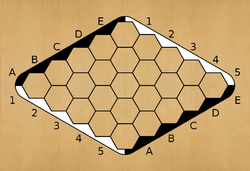
Positive diamond |
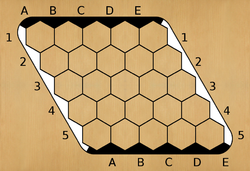
Positive flat |
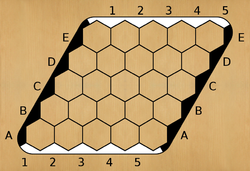
Positive flat II |
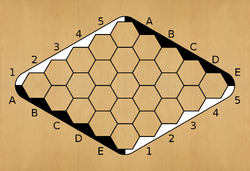
Negative diamond |
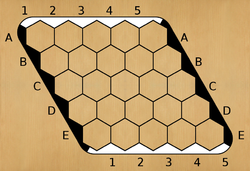
Negative flat |
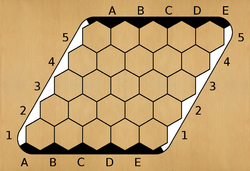
Negative flat II |
List of conventions used
| Origin | Edge coloring | Swap | Passing | Colors | First player | Orientation | |
|---|---|---|---|---|---|---|---|
| Browne | acute | normal | sides | N/A | black/white | black | positive diamond |
| Seymour | acute | normal | pieces | explicit in puzzles, none in book | black/white | black | positive diamond |
| Berge | acute | normal | ? | N/A | black/white | white | negative flat II |
| Hayward and Toft | acute | ? | sides | N/A | black/white | any | diamond |
| Hexy | acute | normal | pieces | none | red/blue | red | positive diamond / positive flat / negative flat II |
| Mohex | acute | normal | N/A | implicit | black/white | black | positive flat |
| HexGui | acute | normal | both | implicit | black/white | black | any |
| Board Game Arena | acute | normal | pieces | explicit | red/blue | red | positive flat |
| Little Golem | acute | normal | pieces | none | black/white | black | positive flat |
| igGameCenter | acute | normal | sides | none | red/blue or black/white | red or black | positive flat |
| PlayOK | acute | normal | pieces | none | black/white | black | positive flat |
| PlayHex | acute | normal | pieces | explicit | red/blue | red | any positive |
| AbstractPlay | acute | normal | pieces | none | red/blue | red | positive flat |
| HexWorld | acute | normal | both | explicit | black/white or red/blue | black or red | any positive |
| TRMPH | acute | normal | N/A | none | black/white | black | positive flat |
| HexWiki | acute | normal | both | N/A | red/blue | red | positive flat |
Notes:
- Browne states that there is no universal convention for which color goes first, but black goes first in all examples in the book.
- Berge states that any player can go first, but white goes first in his example games.
- TRMPH implements swapping incorrectly. It changes the color of the piece, but not its location.
- MoHex does not implement a swap-pieces move. It implements swap-sides, which it incorrectly (and confusingly) calls swap-pieces.
- BoardGameArena has an explicit passing move, but three consecutive passes are not allowed. Therefore, if a player passes, the opponent can effectively reject the pass by passing too.
- AbstractPlay uses red and blue as the default colors, but users can set custom colors for themselves (these are not seen by the opponent). It uses the positive flat orientation and the board can be rotated in increments of 90 degrees.
